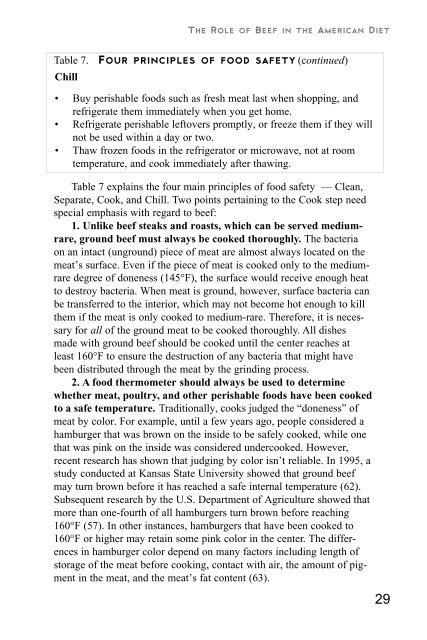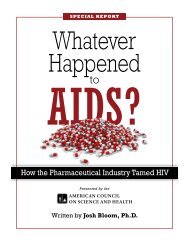The Role of Beef in the American Diet - International Meat Secretariat
The Role of Beef in the American Diet - International Meat Secretariat
The Role of Beef in the American Diet - International Meat Secretariat
Create successful ePaper yourself
Turn your PDF publications into a flip-book with our unique Google optimized e-Paper software.
<strong>The</strong> <strong>Role</strong> <strong>of</strong> <strong>Beef</strong> <strong>in</strong> <strong>the</strong> <strong>American</strong> <strong>Diet</strong><br />
Table 7.<br />
Chill<br />
Four pr<strong>in</strong>ciples <strong>of</strong> food safety (cont<strong>in</strong>ued)<br />
• Buy perishable foods such as fresh meat last when shopp<strong>in</strong>g, and<br />
refrigerate <strong>the</strong>m immediately when you get home.<br />
• Refrigerate perishable leftovers promptly, or freeze <strong>the</strong>m if <strong>the</strong>y will<br />
not be used with<strong>in</strong> a day or two.<br />
• Thaw frozen foods <strong>in</strong> <strong>the</strong> refrigerator or microwave, not at room<br />
temperature, and cook immediately after thaw<strong>in</strong>g.<br />
Table 7 expla<strong>in</strong>s <strong>the</strong> four ma<strong>in</strong> pr<strong>in</strong>ciples <strong>of</strong> food safety — Clean,<br />
Separate, Cook, and Chill. Two po<strong>in</strong>ts perta<strong>in</strong><strong>in</strong>g to <strong>the</strong> Cook step need<br />
special emphasis with regard to beef:<br />
1. Unlike beef steaks and roasts, which can be served mediumrare,<br />
ground beef must always be cooked thoroughly. <strong>The</strong> bacteria<br />
on an <strong>in</strong>tact (unground) piece <strong>of</strong> meat are almost always located on <strong>the</strong><br />
meat’s surface. Even if <strong>the</strong> piece <strong>of</strong> meat is cooked only to <strong>the</strong> mediumrare<br />
degree <strong>of</strong> doneness (145°F), <strong>the</strong> surface would receive enough heat<br />
to destroy bacteria. When meat is ground, however, surface bacteria can<br />
be transferred to <strong>the</strong> <strong>in</strong>terior, which may not become hot enough to kill<br />
<strong>the</strong>m if <strong>the</strong> meat is only cooked to medium-rare. <strong>The</strong>refore, it is necessary<br />
for all <strong>of</strong> <strong>the</strong> ground meat to be cooked thoroughly. All dishes<br />
made with ground beef should be cooked until <strong>the</strong> center reaches at<br />
least 160°F to ensure <strong>the</strong> destruction <strong>of</strong> any bacteria that might have<br />
been distributed through <strong>the</strong> meat by <strong>the</strong> gr<strong>in</strong>d<strong>in</strong>g process.<br />
2. A food <strong>the</strong>rmometer should always be used to determ<strong>in</strong>e<br />
whe<strong>the</strong>r meat, poultry, and o<strong>the</strong>r perishable foods have been cooked<br />
to a safe temperature. Traditionally, cooks judged <strong>the</strong> “doneness” <strong>of</strong><br />
meat by color. For example, until a few years ago, people considered a<br />
hamburger that was brown on <strong>the</strong> <strong>in</strong>side to be safely cooked, while one<br />
that was p<strong>in</strong>k on <strong>the</strong> <strong>in</strong>side was considered undercooked. However,<br />
recent research has shown that judg<strong>in</strong>g by color isn’t reliable. In 1995, a<br />
study conducted at Kansas State University showed that ground beef<br />
may turn brown before it has reached a safe <strong>in</strong>ternal temperature (62).<br />
Subsequent research by <strong>the</strong> U.S. Department <strong>of</strong> Agriculture showed that<br />
more than one-fourth <strong>of</strong> all hamburgers turn brown before reach<strong>in</strong>g<br />
160°F (57). In o<strong>the</strong>r <strong>in</strong>stances, hamburgers that have been cooked to<br />
160°F or higher may reta<strong>in</strong> some p<strong>in</strong>k color <strong>in</strong> <strong>the</strong> center. <strong>The</strong> differences<br />
<strong>in</strong> hamburger color depend on many factors <strong>in</strong>clud<strong>in</strong>g length <strong>of</strong><br />
storage <strong>of</strong> <strong>the</strong> meat before cook<strong>in</strong>g, contact with air, <strong>the</strong> amount <strong>of</strong> pigment<br />
<strong>in</strong> <strong>the</strong> meat, and <strong>the</strong> meat’s fat content (63).<br />
29










